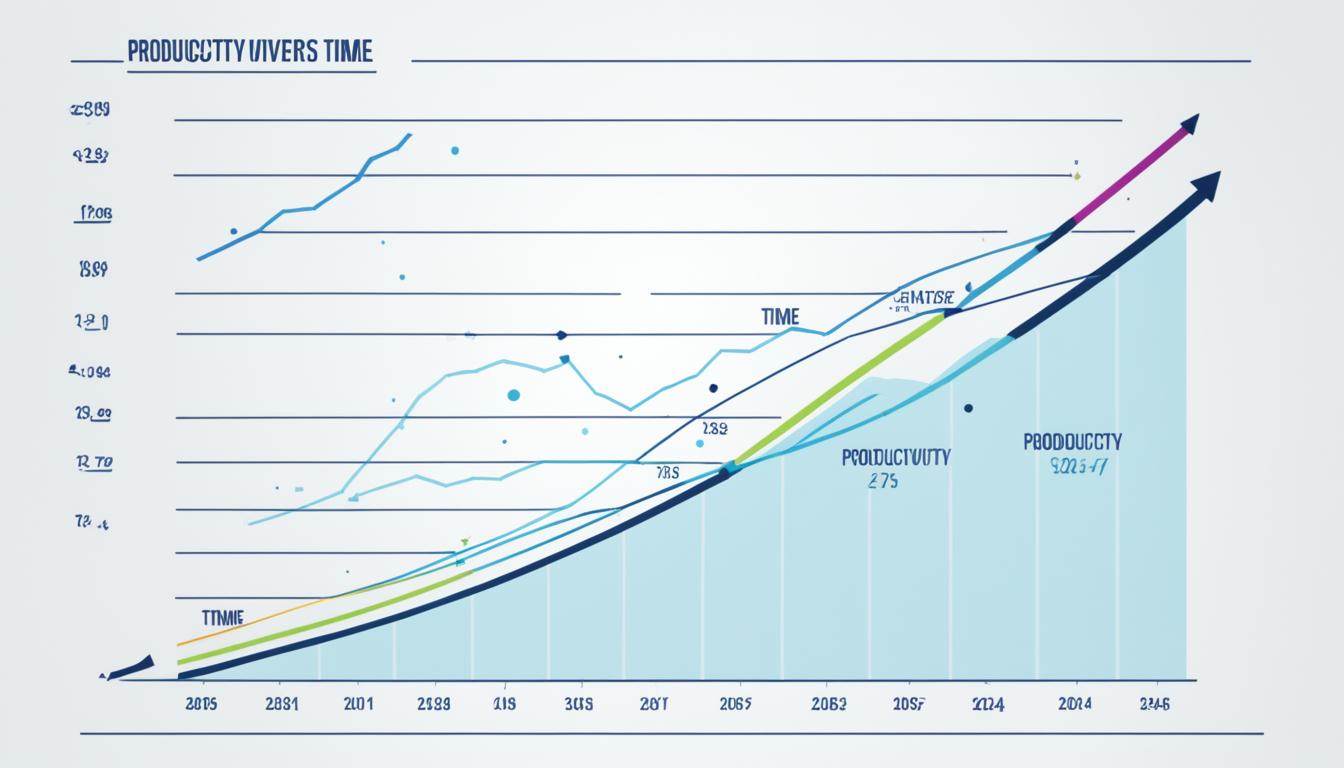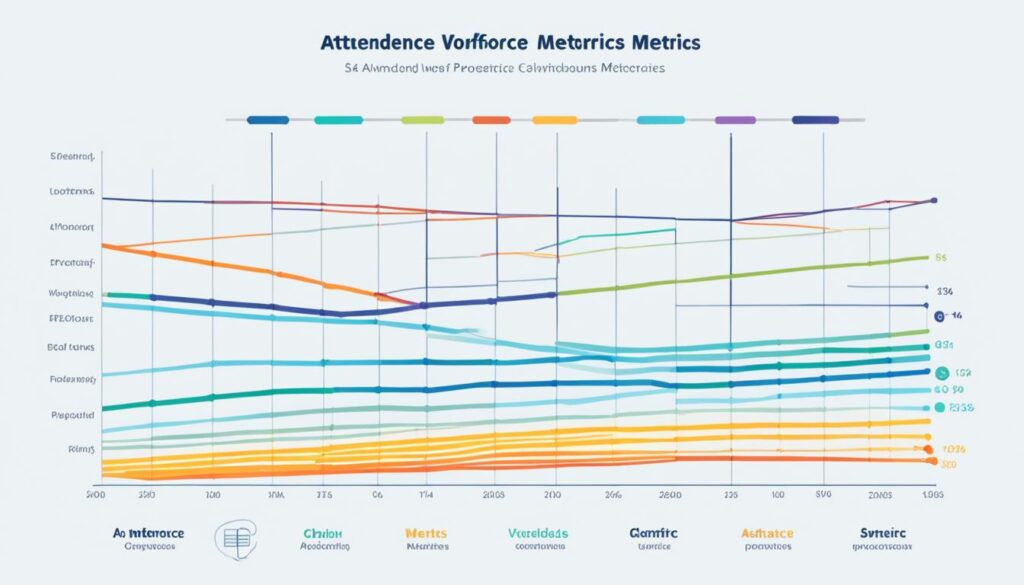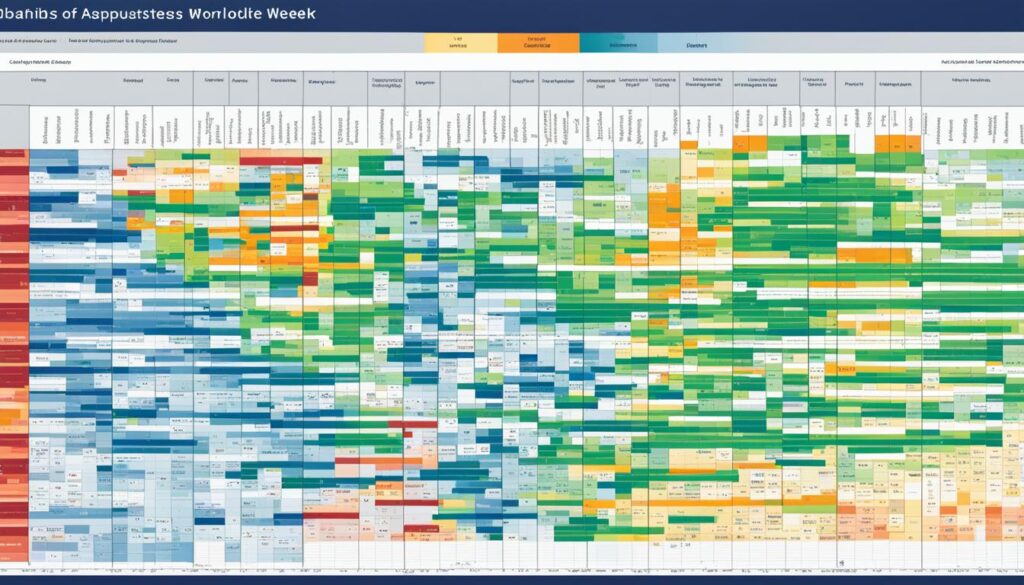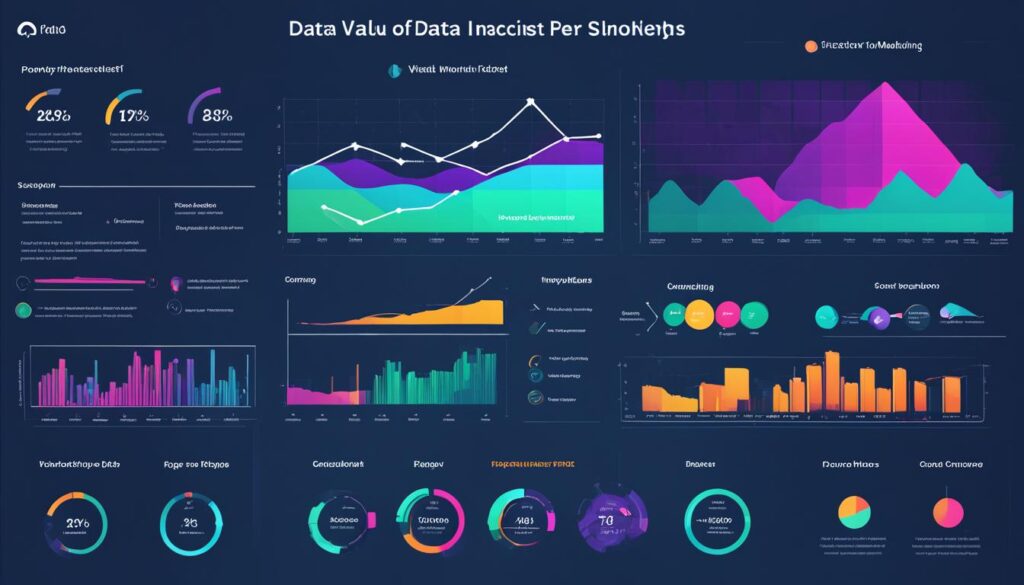Boost Your Success with Productivity Reporting

Are you looking for ways to enhance your business’s efficiency and achieve better outcomes? Do you want to take your decision-making processes to the next level by harnessing the power of data? If so, then productivity reporting might be the key to unlocking your success.
Productivity reporting provides valuable insights into your business’s performance by utilizing data visualization, performance analytics, and business intelligence tools. By tracking key performance indicators (KPIs), analyzing efficiency, and gaining visibility through dashboards and metrics tracking, productivity reporting empowers you to make data-driven decisions that optimize your efficiency and drive your business forward.
Key Takeaways:
- Productivity reporting provides actionable insights for enhancing performance and achieving better outcomes.
- Data visualization, performance analytics, and business intelligence tools enable businesses to track KPIs, analyze efficiency, and gain visibility.
- By utilizing productivity reporting, businesses can make informed, data-driven decisions that optimize efficiency and drive success.
- Dashboard and metrics tracking provide a clear picture of productivity, enabling strategic decision-making.
- Productivity reporting tools make it easy to generate comprehensive reports that support strategic decision-making processes.
Measure Success: Understanding Workforce Metrics
One key aspect of productivity reporting is the ability to measure success through workforce metrics. By evaluating and tracking employee performance using objective data, businesses can accurately measure productivity levels. This allows you to recognize high performers and reward them accordingly, as well as identify areas of underperformance and address them with confidence.
Utilizing productivity reporting tools enables you to establish clear metrics for success and evaluate employee performance based on tangible data rather than subjective assessments. By leveraging workforce metrics, you can make data-driven decisions that optimize performance and drive your business forward.
When it comes to measuring success, objective data provides undeniable evidence of employee performance and productivity. It removes ambiguity and fosters fairness in recognizing and rewarding high performers. Additionally, objective data allows you to identify areas of underperformance and implement targeted strategies to address them effectively.
Workforce metrics provide valuable insights into various aspects of employee performance, such as individual productivity, task completion rates, and adherence to quality standards. By analyzing this data, you can gain a comprehensive understanding of your workforce’s strengths and weaknesses, allowing you to take appropriate action to maximize productivity and overall performance.
Key Workforce Metrics:
| Metric | Description |
|---|---|
| Employee Productivity | Measures the output or efficiency of employees in terms of completed tasks, projects, or sales. |
| Quality of Work | Evaluates the accuracy, attention to detail, and adherence to standards in the work performed by employees. |
| Attendance and Punctuality | Tracks employee timekeeping, including absences, tardiness, and adherence to work schedules. |
| Collaboration and Communication | Assesses how well employees work together and communicate effectively to achieve common goals. |
These metrics, among others, provide you with valuable insights into the performance and productivity of your workforce. By regularly monitoring and analyzing these metrics, you can make more informed decisions and take proactive measures to optimize efficiency and ensure ongoing success.

Visual representation of workforce metrics can be a powerful tool for understanding and communicating productivity trends. The image above illustrates how data visualization can provide a clear and comprehensive overview of employee performance, making it easier to identify patterns and areas for improvement.
Ultimately, understanding workforce metrics is key to measuring success and driving continuous improvement. By leveraging objective data, you can reward high performers, address underperformance, and optimize your workforce’s productivity to achieve your business goals.
Work Scheduling Analytics: Ensuring Equitable Workloads
Work scheduling analytics is a crucial component of productivity reporting. By utilizing these analytics, businesses can ensure more equitable workloads for their employees, which helps prevent burnout and promotes a healthy work environment.
Through productivity reporting tools, businesses can analyze individual work schedules, track work hours, and identify any imbalances or excessive workloads. This data can then be used to make informed decisions about workload allocation, ensuring that all team members have a fair and manageable workload.
Benefits of Work Scheduling Analytics
Implementing work scheduling analytics provides several benefits for businesses:
- Equitable Workloads: By analyzing work schedules and tracking hours, businesses can distribute work more equitably among their employees. This ensures that no one is unfairly burdened with excessive workloads, reducing the risk of burnout and maintaining a healthy work environment.
- Preventing Burnout: By identifying imbalances and excessive workloads, businesses can proactively prevent burnout among their employees. This leads to improved productivity, increased job satisfaction, and better overall well-being.
- Optimizing Resource Allocation: Work scheduling analytics enables businesses to allocate resources more efficiently. By identifying peak work periods, businesses can allocate additional resources or adjust schedules to ensure optimal productivity levels.
- Improved Decision-Making: Data-driven insights from work scheduling analytics empower businesses to make informed decisions regarding workload allocation. This helps create a more efficient and productive workforce, leading to better outcomes and increased success.
By leveraging work scheduling analytics as part of productivity reporting, businesses can create a harmonious work environment with equitable workloads, prevent burnout, and ultimately drive productivity and success.

| Benefits of Work Scheduling Analytics | Descriptions |
|---|---|
| Equitable Workloads | Ensures fair distribution of work among employees |
| Preventing Burnout | Identifies imbalances and excessive workloads to prevent burnout |
| Optimizing Resource Allocation | Efficiently allocate resources based on work schedules |
| Improved Decision-Making | Make informed decisions about workload allocation |
Data-Driven Insights for Better Decision-Making
Productivity reporting provides data-driven insights that empower businesses to make better decisions. By analyzing productivity data and metrics, you can lead with confidence and make informed, data-driven decisions. These insights enable you to identify areas of improvement, optimize resource allocation, and enhance performance across your organization.
With access to real-time data and analytics, you can stay agile and quickly adapt to changing circumstances, resulting in improved outcomes and higher levels of success. By utilizing productivity reporting tools, you gain a deep understanding of your business operations, allowing you to make strategic decisions based on accurate and relevant information.
Unlocking the Power of Data
Imagine having the ability to identify trends, patterns, and opportunities that can propel your business forward. That’s the power of data-driven insights. By leveraging the wealth of data available to you, you can uncover valuable insights that can shape your strategy and drive growth.
- Identify areas of underperformance: Pinpoint departments or processes that are not meeting their goals or standards, and take proactive steps to address the issue.
- Optimize resource allocation: By analyzing data on employee productivity and resource utilization, you can allocate your resources more effectively, ensuring that tasks are assigned to the right people at the right time.
- Enhance decision-making: Data-driven insights provide you with a solid foundation for making informed decisions. Whether it’s about expanding into new markets, launching new products, or optimizing your supply chain, you can rely on data to guide your choices.
Visualizing Data for Actionable Insights
Raw data can be overwhelming, but with the right tools, you can transform it into visual representations that are easy to understand and act upon. Data visualization allows you to uncover meaningful patterns and correlations, enabling you to make more impactful decisions.
Take advantage of interactive dashboards and charts to explore your data from different perspectives. Identify trends, spot anomalies, and drill down into specific metrics that matter to your business. By presenting data visually, you can communicate complex concepts more effectively and encourage collaboration among your teams.
Staying Ahead of the Competition
In today’s fast-paced business environment, staying ahead of the competition requires making informed decisions quickly. By embracing data-driven insights, you are better equipped to respond to market changes, customer demands, and industry trends.
Keep a pulse on your business by regularly analyzing your productivity data and metrics. Leverage tools that provide real-time updates and alerts, ensuring that you have the information you need when you need it. With data-driven insights, you can confidently lead your organization towards growth and success.

Boost Productivity with Smart Work Scheduling Analytics
Are you looking for ways to boost productivity and streamline your business processes? Look no further than smart work scheduling analytics. By utilizing a comprehensive toolkit that includes automated scheduling and shift swapping options, you can optimize workforce management and maximize efficiency.
With smart work scheduling analytics, you can gain valuable insights into scheduling inefficiencies, enabling you to make data-driven decisions that improve productivity. Let’s take a closer look at the key features of this powerful tool:
Automated Scheduling
Automated scheduling eliminates the need for manual scheduling processes, saving you time and reducing errors. This feature allows you to create optimized schedules based on employee availability, workload, and other relevant factors. By ensuring that shifts are adequately staffed, you can prevent overburdened employees and maintain a smooth workflow.
Shift Swapping
Shift swapping options offer flexibility to your employees, making it easier for them to adjust their schedules to accommodate last-minute changes. This feature improves employee satisfaction and reduces the administrative burden of managing schedule changes. Empowering your employees with the ability to swap shifts fosters a collaborative and engaged workforce.
By harnessing the power of smart work scheduling analytics, you can streamline your processes, reduce costs, and boost employee productivity. Take a look at the table below to see the impact of implementing this tool:
| Benefits of Smart Work Scheduling Analytics | Impact on Productivity |
|---|---|
| Automated scheduling | Increase efficiency and reduce errors |
| Shift swapping | Improved employee satisfaction and flexibility |
| Optimized workforce management | Enhanced productivity and minimized downtime |
As you can see, implementing smart work scheduling analytics has a significant impact on productivity. By streamlining processes and empowering your employees, you can create a more efficient and collaborative work environment.
Don’t let scheduling inefficiencies hold your business back. Embrace the power of smart work scheduling analytics and witness the transformative effects on your productivity and bottom line.
Transparent Workplace: Ensuring Compliance and Transparency
A transparent workplace is crucial for effective productivity reporting. By implementing features such as work hours calculation and audit trails, businesses can ensure compliance with labor laws, maintain transparency, and foster a more secure work environment.
Work hours calculation tools are essential for accurate tracking of employee work hours, which is vital for compliance purposes. With these tools, businesses can easily monitor and record the number of hours worked by each employee, ensuring adherence to labor regulations. This data not only helps businesses fulfill their legal obligations but also provides valuable insights for optimizing workforce management.
Additionally, audit trails play a vital role in maintaining transparency in auditing processes. They provide a comprehensive record of all work-related activities and transactions, enabling businesses to identify potential issues and demonstrate compliance with internal policies and external regulations. Audit trails serve as a safeguard against fraudulent activities and promote a culture of accountability within the organization.
By embracing transparency measures such as work hours calculation and audit trails, businesses can build trust and credibility among their employees and stakeholders. This fosters a culture of honesty, open communication, and accountability, ultimately leading to higher levels of productivity and performance.
The Benefits of a Transparent Workplace:
- Ensures compliance with labor laws
- Provides accurate work hours calculation
- Fosters transparency and open communication
- Safeguards against fraudulent activities
- Promotes a culture of accountability and trust

| Benefits | Description |
|---|---|
| Ensures compliance with labor laws | Transparent workplace practices help businesses adhere to labor laws and regulations, minimizing the risk of penalties and legal issues. |
| Provides accurate work hours calculation | Work hours calculation tools enable businesses to track employee work hours accurately, ensuring fair compensation and compliance with labor regulations. |
| Fosters transparency and open communication | A transparent workplace promotes open communication, trust, and collaboration among employees, leading to improved productivity and a positive work environment. |
| Safeguards against fraudulent activities | Audit trails serve as a deterrent to fraudulent activities and provide a clear record of work-related transactions, ensuring transparency and accountability. |
| Promotes a culture of accountability and trust | A transparent workplace cultivates a culture of accountability, where employees take ownership of their actions and trust each other, leading to improved performance and job satisfaction. |
Conclusion
In conclusion, productivity reporting is the key to unlocking the full potential of your business. By harnessing the power of data-driven insights, you can make informed decisions that optimize efficiency and drive success. With the help of productivity reporting tools, you can measure the success of your business, evaluate the performance of your employees, and track key productivity metrics.
Work scheduling analytics and transparent workplace practices further enhance productivity and ensure compliance with labor laws. By using these tools, you can ensure equitable workloads, prevent burnout, and create a healthy work environment. Transparent practices, such as accurate work hours calculation and audit trails, promote accountability and trust within your organization.
By making data-driven decisions and optimizing efficiency, you can take your business to new heights of productivity and success. Productivity reporting empowers you to identify areas for improvement, allocate resources effectively, and adapt to changing circumstances. Embrace the power of productivity reporting and unlock the full potential of your business today!
FAQ
What is productivity reporting?
Productivity reporting is a powerful tool that enables businesses to measure success, evaluate employee performance, and quantify productivity. By utilizing data visualization, performance analytics, and business intelligence tools, businesses can track key performance indicators (KPIs), analyze efficiency, and gain valuable insights through dashboards and metrics tracking.
How can productivity reporting help businesses measure success?
By evaluating and tracking employee performance using objective data, productivity reporting allows businesses to accurately measure productivity levels. This enables them to recognize high performers and reward them accordingly, as well as identify areas of underperformance and address them with confidence. Productivity reporting tools establish clear metrics for success and evaluate employee performance based on tangible data.
How can work scheduling analytics contribute to productivity reporting?
Work scheduling analytics help ensure more equitable workloads for employees, preventing burnout and promoting a healthy work environment. Through productivity reporting tools, businesses can analyze individual work schedules, track work hours, and identify any imbalances or excessive workloads. This data can then be used to make informed decisions about workload allocation, ensuring fair and manageable workloads for all team members.
How do data-driven insights contribute to better decision-making?
By analyzing productivity data and metrics, businesses can make informed, data-driven decisions. These insights enable businesses to identify areas of improvement, optimize resource allocation, and enhance overall performance. With access to real-time data and analytics, businesses can stay agile and quickly adapt to changing circumstances, resulting in improved outcomes and higher levels of success.
How can smart work scheduling analytics boost productivity?
Smart work scheduling analytics, through a comprehensive toolkit that includes automated scheduling and shift swapping features, allow businesses to streamline processes and optimize workforce management. These analytics provide insights into scheduling inefficiencies, enabling data-driven decisions to improve productivity. Automated scheduling saves time, reduces errors, and ensures shifts are adequately staffed, while shift swapping offers flexibility for employees and accommodates last-minute changes.
Why is a transparent workplace essential for productivity reporting?
A transparent workplace is crucial for productivity reporting as it ensures compliance with labor laws, maintains transparency, and creates a secure work environment. Work hours calculation tools allow businesses to accurately track employee work hours for compliance purposes. Audit trails provide a detailed record of work-related activities, ensuring transparency in auditing processes. Implementing these transparency measures builds trust, credibility, and promotes productivity and accountability.
How does productivity reporting contribute to employee productivity and business success?
By utilizing data-driven insights, productivity reporting enables businesses to make informed decisions, optimize efficiency, and achieve better outcomes. It allows businesses to measure success, evaluate employee performance, track key metrics, and identify areas of improvement. With the ability to analyze productivity data and metrics, businesses can unlock their full potential, drive sustainable growth, and enhance overall performance.






